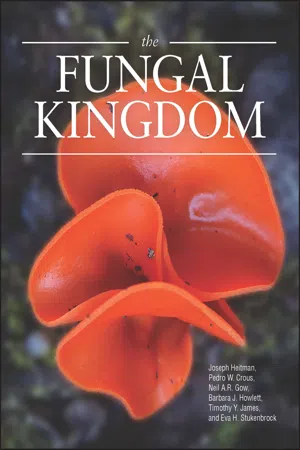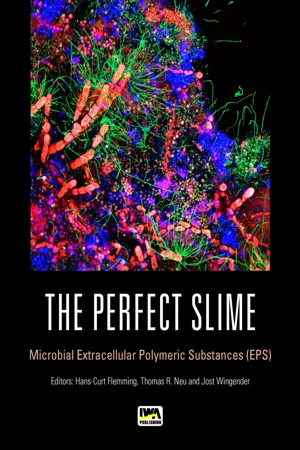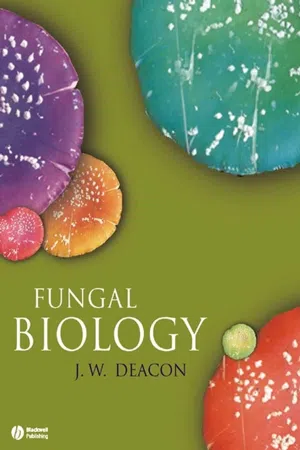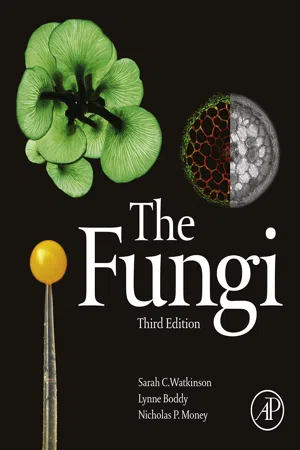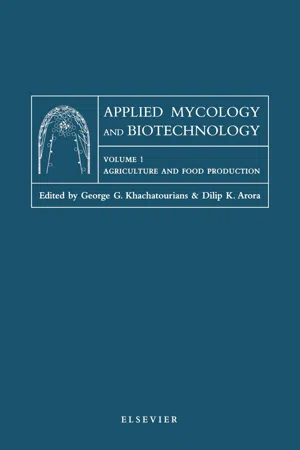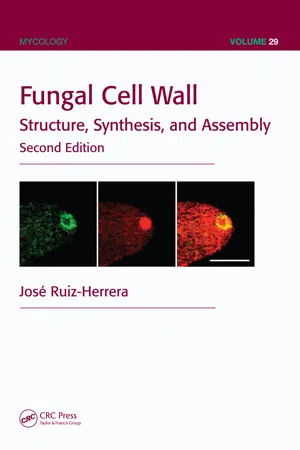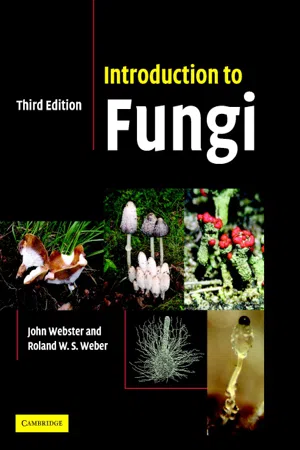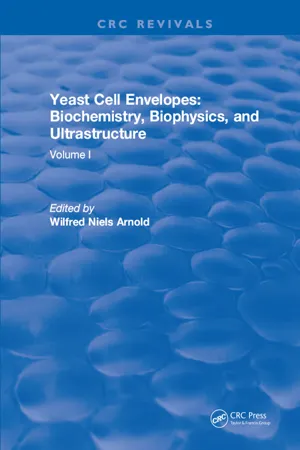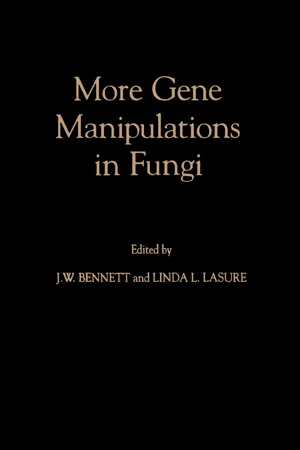Biological Sciences
Fungi Cell Wall
The fungal cell wall is a rigid structure that surrounds the cell membrane of fungi. It provides support and protection for the fungal cell and is primarily composed of chitin, glucans, and other complex carbohydrates. The cell wall plays a crucial role in maintaining the shape and integrity of the fungal cell, as well as in interactions with the environment.
Written by Perlego with AI-assistance
Related key terms
1 of 5
12 Key excerpts on "Fungi Cell Wall"
- eBook - ePub
- Joseph Heitman, Barbara J. Howlett, Pedro W. Crous, Eva H. Stukenbrock, Timothy Yong James, Neil A. R. Gow(Authors)
- 2017(Publication Date)
- ASM Press(Publisher)
8 ). The cell wall provides a valuable source of most diagnostic antigens that are used to detect human fungal infections, and it represents a rich source of unique targets for chemotherapeutic treatment of pathogens. Therefore, fungi are in no small measure defined by, and live through, the interface of their cell walls. Recent progress has been considerable, yet some of the most important and elusive questions in fungal cell biology relate to basic aspects of fungal cell wall biosynthesis and function. This review focuses on the biosynthesis and functions of fungal cell walls with an emphasis on model pathogenic species where the most detailed information is often available.COMPOSITION AND STRUCTURE
Structural Organization and Cell Wall Layers
Fundamentally, fungal walls are all engineered in a similar way. The wall structure directly affects wall function and interactions with the environment including immune recognition by plants and animals. Fibrous and gel-like carbohydrate polymers form a tensile and robust core scaffold to which a variety of proteins and other superficial components are added that together make strong, but flexible, and chemically diverse cell walls. Most cell walls are layered, with the innermost layer comprising a relatively conserved structural skeletal layer and the outer layers more heterogeneous and tailored to the physiology of particular fungi. In most fungal species the inner cell wall consists of a core of covalently attached branched β-(1,3) glucan with 3 to 4% interchain and chitin (9 , 10 ). β-(1,3) Glucan and chitin form intrachain hydrogen bonds and can assemble into fibrous microfibrils that form a basket-like scaffold around the cell. This exoskeleton represents the load-bearing, structural component of the wall that resists the substantial internal hydrostatic pressure exerted on the wall by the cytoplasm and membrane. This branched β-(1,3):β-(1,6) glucan is bound to proteins and/or other polysaccharides, whose composition may vary with the fungal species (Fig. 1 ). However, yeast cells have bud scars that tend to have fewer outer cell wall layers covering them and therefore have exposed inner wall chitin and β-(1,3) glucan (11 - eBook - PDF
- Dilip K. Arora(Author)
- 2003(Publication Date)
- CRC Press(Publisher)
2 THE CELL WALL The cell wall is a characteristic structure present in many organisms whose life style to grow in an environment with continuously changing water potential can be described as an absorptive one. Thus, the accumulation of large concentrations of osmotically active molecules requires the presence of a structure that will assist in maintaining the integrity of the cell membranes. In addition, the adventurous, and at times, invasive proliferation of the fungal filament in a variety of diverse environments requires the presence of effective mechanisms to defend the fungal cell from external perils. The cell wall is a prime example of an efficient mechanical exocellular defense system. Understanding the structure of the cell wall and the synthesis of its components is essential for elucidation of the processes involved in fungal growth and development. This understanding includes the fundamental aspects of filament elongation and branching as well as various aspects of differentiation, pathogenicity, absorption, and secretion. 2.1 Composition The fungal cell wall accounts for approximately 25% of the mycelial dry weight. Approximately 80% of the cell wall dry weight is comprised of polysaccharides (Ruiz- Herrera 1992). The remaining 20% is comprised of proteins, lipids, and various inorganic salts. The predominant carbohydrate polymers found in different fungi are various forms of glucans and chitin. These sugars, synthesized and positioned in a nonuniform, yet highly regulated manner provide the external skeleton of the hyphal cell and are synthesized mainly at the apical region of the growing hyphae. Nonetheless, additional components (in particular—cell wall-associated proteins) are involved in determining the cell surface properties of the growing or nascent hypha. Cell wall associated proteins are involved in the restriction of cell permeability to detrimental compounds and/or proteins present in the environment. - eBook - PDF
The Perfect Slime
Microbial Extracellular Polymeric Substances (EPS)
- Hans-Curt Flemming, Thomas R. Neu, Jost Wingender(Authors)
- 2016(Publication Date)
- IWA Publishing(Publisher)
Here we have reviewed the characteristics, properties and functions of fungal EPS in microbial biofilms – and would herewith like to compensate for the relative imbalances in knowledge between fungal and bacterial producers and users of EPS. 14.3 FUNGAL CELL WALL AND BEYOND An outermost barrier of any fungal cell starts just outside a plasma membrane as a structurally unique cell wall that confers both protective and aggressive properties (Latge, 2007). Cell walls maintain the functional shape of any fungal cell from hyphae to yeast. These rigid structures support a forceful penetrating for the invasion of hosts tissues and lifeless organic and inorganic substrates (Bechinger et al. 1999). Cell walls protect the fungal cell from the environment and participate in adhesion of the cells to each other and the underlying substrate. Cell wall of yeasts accounts for up to 30% of the dry weight biomass and, thus, represent a substantial metabolic investment of the organism (Klis et al. 2014). Disruptions of the cell wall structure have been proven to affect the growth and morphology of the fungal cell, often making it susceptible to lysis and death (Bulawa, 1993; Kapteyn et al. 1999; Bowman & Free, 2006; Latge, 2007). Any fungal cell is thus surrounded by a complex cross-linked network of chitin, branched glucans, mannans and glycoproteins (Bowman & Free, 2006; Reilly & Doering, 2009; Mahapatra & Banerjee, 2013). The inner rigid core in the plasma membrane proximity is formed by chitin and -glucans (Bartnicki-Garcia, 1968; Figueiredo & Barreto-Bergter, 2014). External layers are more varied and harbour many loosely anchored Snapshots of fungal extracellular matrices 271 and structurally complex polysaccharides, glycoproteins, enzymes and lipids. - eBook - ePub
Microbial Glycobiology
Structures, Relevance and Applications
- Anthony P Moran, Otto Holst, Patrick Brennan, Mark von Itzstein(Authors)
- 2009(Publication Date)
- Academic Press(Publisher)
t -CWPs have a common modular structure, with an N-terminal secretion signal, then a well-folded functional enzymatic or ligand binding domain, a middle region of tandem repeats, a C-terminal serine- and threonine-rich highly glycosylated “stalk” and a C-terminal GPI addition signal. Their functional regions include enzymes active in cell wall biogenesis and maintenance and nutrient acquisition; transport functions; and cell adhesion proteins that mediate interactions between fungal cells, pathogen and host and in biofilms. Therefore, fungal walls have functions including those assumed by membrane, cytoskeleton and extracellular matrix in other organisms.Keywords: β-Glucan; Chitin; Glycoprotein; Glycosylphosphatidylinositol anchor; N-Glycosylation; O-glycosylation; Glucan-protein ester1. Introduction
Among the defining characteristics of fungi are cell walls with complex architecture. Fungal walls are substantially thicker than bacterial walls and normally make up 10–30% of the biomass. They are freely permeable to small molecules and so solute transport systems and signalling receptors remain in the membrane, and are homologous to those in other eukaryotes. Walls have obvious functions in osmotic and mechanical support of the cells, which have less extensive cytoskeletons than do motile eukaryotes. Walls are also the site of cell contact with the environment, so the outer surface of the wall is adapted to participate in the cell–cell interactions characteristic of colony and biofilm formation, as well as host–fungal adherence in symbiotic, commensal and pathogenic states.A variety of activities reside in glycoproteins embedded within the walls and linked with fungal wall polysaccharides. Many of these proteins are adhesins; while others cross-link cell wall polysaccharides or are carbohydrate-active enzymes. Such enzymes have functions such as wall biogenesis and turnover, modulation of wall structure in response to stress and to fungal morphogenesis and, conceivably, also in the formation of the extracellular matrix of biofilms. Finally, some cell wall glycoproteins are involved in iron and sterol acquisition or in coping with oxidative stress (Yin et al. - eBook - PDF
- J. W. Deacon(Author)
- 2009(Publication Date)
- Wiley-Blackwell(Publisher)
They are also distinct from the “fission yeasts” such as Schizosaccharomyces species, which do not bud but instead form filaments that fragment by septation into brick-like cells (arthrospores, or arthroconidia). Fungal walls and wall components In recent years it has become clear that fungal walls serve many important roles, quite apart from the obvi- ous role of providing a structural barrier. For example, the way in which a fungus grows – whether as cylin- drical hyphae or as yeasts – is determined by the wall components and the ways in which these are assem- bled and bonded to one another. The wall is also the interface between a fungus and its environment: it protects against osmotic lysis, it acts as a molecular sieve regulating the passage of large molecules through the wall pore space, and if the wall contains pigments such as melanin it can protect the cells against ultraviolet radiation or the lytic enzymes of other organisms. In addition to these points, the wall can have several physiological roles. It can contain binding sites for enzymes, because many disaccharides (e.g. sucrose and cellobiose) and small peptides need to be degraded to monomers before they can pass through the cell membrane, and this is typically achieved by the actions of wall-bound enzymes (Chapter 6). The wall also can have surface components that mediate the inter- actions of fungi with other organisms, including plant and animal hosts. All these features require a detailed understanding of wall structure and architecture. The major wall components The primary approach to investigating the wall com- position of fungi is to disrupt fungal cells and purify the walls by using detergents and other mild chemical treatments, then use acids, alkalis and enzymes to degrade the walls sequentially. - eBook - ePub
- Sarah C. Watkinson, Lynne Boddy, Nicholas Money(Authors)
- 2015(Publication Date)
- Academic Press(Publisher)
turgor . The increase in internal pressure allows the cell to approach a condition of homeostasis in which water influx matches the increase in cell volume that occurs during growth.The wall is a highly dynamic structure, resisting expansion over much of its surface, but extending in specific regions including hyphal tips and yeast buds. The adaptive significance of the wall is controversial. It is important to avoid the chicken-and-egg trap of suggesting that the cell wall functions to resist the explosive effects of turgor, because the cell would not be pressurised without the resistive behaviour of its wall. The cell wall allows the cell to generate turgor pressure, so perhaps it is more fruitful to think about why turgor might be useful. We will come back to this issue later in the chapter.The fungal cell wall is a porous macromolecular composite assembled at the surface of the plasma membrane (Figure 2.2 ). It contains stress-bearing microfibrils of chitin , linear polymers of glucose, or glucans , and a variety of cell wall proteins (CWP). The chitin polymer is built from β-1 → 4-linked monomers of the amino sugar, N -acetyl-d -glucosamine (Figure 2.3 ). Adjacent chitin chains assemble into hydrogen-bonded antiparallel arrays, producing microfibrils that can reach lengths of more than 1 μm. Chitin microfibrils have tremendous tensile strength; when chitin is disrupted, the cell loses its osmotic stability and may rupture. Chitosan , or β-1 → 4-glucosamine, is a polymer of the deacetylated sugar that is produced by many fungi in addition to chitin. β-1 → 3-glucan is often the most abundant wall polymer (Figure 2.4 ). The β-1 → 3-glycosidic linkage in glucans twists the polymer and three glucan chains form a triple helix that is held together by hydrogen bonds. β-1 → 3-glucans are connected with β-1 → 6-glucans in the mature wall structure to produce a highly branched elastic network of polymers. The structural proteins in the cell wall are glycoproteins with N - and O -linked carbohydrates. These include mannoproteins - eBook - PDF
- (Author)
- 2001(Publication Date)
- Elsevier Science(Publisher)
Synthesis of wall components and rigidification of the cell wall therefore represent two closely integrated processes which will be considered below. 2.1. Chemical composition of fungal cell walls Fungi from different taxa vary considerably in the composition of their cell walls (Wessels and Sietsma, 1981; Ruiz-Herrera, 1992). However, all hyphal walls are constructed to a similar scheme consisting of a structural scaffold of cross-linked fibres embedded in or surrounded by a matrix of gel-like and crystalline components (Sentandreu et al., 1994). In higher fungi (Asco- and Basidiomycota and Fungi Imperfecti), the two most important cell wall polymers are glucans composed of glucose units, and chitin, a polymer of ~-(1,4)-linked N- acetylglucosamine. Several types of glucan may be found in mature walls of higher fungi; linear a-(1,3)-linked chains (Wessels et al., 1972) or chains 16 Figure 1. Hyphal tip of Fusarium acuminatum. Secretory vesicles are clustered in the apex whereas mitochondria are located subapically, associated with microtubules (arrowheads). A Golgi equivalent is also visible (arrow). Bar, 1 ~tm. Reproduced from The Journal of Cell Biology 87, 55-64 (1980) by copyright permission of The Rockefeller University Press. Original print kindly supplied by R. J. Howard. 17 Figures 2-4. Light microscopy of living hyphae of Botrytis cinerea (for methods, see Weber et al., 1999). Figure 2. Distribution of nuclei in a tip cell. The position of the apical dome is indicated by an arrowhead. Figure 3. Uptake of Neutral Red into vacuoles in an apical cell. Figure 4. Uptake of Neutral Red into vacuoles in a mature hyphal segment. Bar, 10 ~m. containing a mixture of (z-(1,3)- and a-(1,4)-bonds (Bobbitt and Nordin, 1982) are soluble in alkaline solutions (1 M KOH) and constitute approx. 50% of the total cell wall glucan (Sietsma and Wessels, 1994). - eBook - PDF
Chitin, Chitosan, Oligosaccharides and Their Derivatives
Biological Activities and Applications
- Se-Kwon Kim(Author)
- 2010(Publication Date)
- CRC Press(Publisher)
It is probably a universal component of fungal walls serving as a fibrous strengthen-ing element responsible for cell wall rigidity. Fungi that were considered to lack chitin, such as many Oomycetes and the fission yeasts, have been shown to have small amounts (Dietrich 1973). However, the fungal cell wall contains variable amounts of chitin. In many systems chitin is a major constituent of the cell wall, while in others, it is involved only in cell division or reproductive CONTENTS 3.1 Introduction ............................................................................................................................ 25 3.2 Occurrence of Chitin and Chitosan in the Microbial World .................................................. 25 3.3 Biotechnological Production ................................................................................................... 26 3.3.1 Chitin and Chitosan Producer Strains ........................................................................ 30 3.3.2 Cultivation Condition .................................................................................................. 30 3.3.3 Fermentation Technique ............................................................................................. 32 3.4 Physicochemical Properties and Commercial Importance of Microbial Chitin and Chitosan ........................................................................................................................... 33 3.5 Conclusions and Perspectives ................................................................................................. 33 References ........................................................................................................................................ 34 26 Chitin, Chitosan, Oligosaccharides and Their Derivatives structures and is virtually absent otherwise. - eBook - PDF
Fungal Cell Wall
Structure, Synthesis, and Assembly, Second Edition
- José Ruiz-Herrera(Author)
- 2016(Publication Date)
- CRC Press(Publisher)
Fungal Cell Wall: Structure, Synthesis, and Assembly ,.Boca.Raton,. FL:.CRC.Press . .With.permission.from.Taylor.&.Francis . Note: tr.=.traces;.+/–.=.less.than.1%;.+.=.1 .1–5%; .++.=.6–20%;.+++.=.more.than.21%.of.the.total.sugars.present. in.the.wall . a. Glc.=.glucose;.Gal.=.galactose;.GlcN.=.glucosamine.(a.product.of.polysaccharides.containing.glucosamine.or. N -acetylglucosamine);. Mann. =. mannose;. GalN. =. galactosamine. (a. product. of. polysaccharides. containing. galactosamine.or. N -acetylgalactosamine);.Glucur.=.glucuronic.acid;.Rham.=.rhamnose;.Fuc.=.fucose;.Xyl.=. xylose;.Ara.=.arabinose . Table 2.2 Components.of.the.Fungal.Cell.Walls Class Cellular function Chemical nature Examples Structural.(Fibrillar) Rigidity Polysaccharides Chitin Shape — β -1,3-glucans Amorphous Cementing Polysaccharides, Mannogalactan Enzymatic Glycoproteins Invertase Recognition — Aglutinins 10 Fungal cell wall: Structure, synthesis, and assembly where.glucosyl.units.are.linked.through.alternating. β -1,3,.and. β -1,4.bonds,.in.a.similar. fashion.to.the.case.of.the. α -bound.polysaccharide.nigeran.(see.below) . .This.polysaccharide. is.covalently.bound.to.the.common. β -1,3-glucan. Chitin.is.normally.present.in.lower.amounts.than. β -glucans,.but.its.presence.is.univer-sal.in.the.fungal.kingdom,.thus.being.the.basic.structural.polysaccharide.in.the.cell.walls. of.fungi . .Chitin.is.a.linear.and.large.polymer.made.of.residues.of. N -acetylglucosamine. linked.through. β −1,4-glycosidic.bonds . .Chains.of.the.polysaccharide.associate.by.hydro-gen. bonds. to. form. microfibrils . . Depending. on. the. arrangements. of. the. chains. in. the. microfibrils,.three.different.forms.have.been.shown.to.exist.in.nature:. β -chitin.,.with.par-allel.chains.[i .e., .all.chains.in.the.same.orientation.(polarity)],. α -chitin,.where.chains.are. antiparallel.(polarity.of.the.chains.alternates),.and. γ -chitin,.in.which.two.parallel.chains. are.adjacent.to.one.antiparallel.chain . - eBook - PDF
- John Webster, Roland Weber(Authors)
- 2007(Publication Date)
- Cambridge University Press(Publisher)
All images to same scale. 4 INTRODUCTION A little behind the apical dome, a region of intense biosynthetic activity and energy genera-tion is indicated by parallel sheets of endoplas-mic reticulum and an abundance of mitochondria (Figs. 1.2b, 1.3). The first nuclei usually appear just behind the biosynthetic zone (Fig. 1.2c), followed ultimately by a system of ever-enlarging vacuoles (Fig. 1.2d). These may fill almost the entire volume of mature hyphal regions, making them appear empty when viewed with the light microscope. 1.2.2 Architecture of the fungal cell wall Although the chemical composition of cell walls can vary considerably between and within different groups of fungi (Table 1.1), the basic design seems to be universal. It consists of a structural scaffold of fibres which are cross-linked, and a matrix of gel-like or crystalline material (Hunsley & Burnett, 1970; Ruiz-Herrera, 1992; Sentandreu et al ., 1994). The degree of cross-linking will determine the plasticity (exten-sibility) of the wall, whereas the pore size (permeability) is a property of the wall matrix. The scaffold forms the inner layer of the wall and the matrix is found predominantly in the outer layer (de Nobel et al ., 2001). In the Ascomycota and Basidiomycota, the fibres are chitin microfibrils, i.e. bundles of linear b -(1,4)-linked N -acetylglucosamine chains (Fig. 1.5), which are synthesized at the plasma membrane and extruded into the growing (‘nascent’) cell wall around the apical dome. The cell wall becomes rigid only after the microfibrils have been fixed in place by cross-linking. These cross-links consist of highly branched glucans (glucose polymers), especially those in which the glucose moieties are linked by b -(1,3)-and b -(1,6)-bonds (Suarit et al ., 1988; Wessels et al ., 1990; Sietsma & Wessels, 1994). Such b -glucans are typically insoluble in alkaline solutions (1 M KOH). - eBook - ePub
- Leo H Arnold(Author)
- 2018(Publication Date)
- CRC Press(Publisher)
In place of cellulose, which is universally present in the cell walls of higher plants, they contain other β-glucans, in which (1→3) and (1→6) linkages predominate, and occasionally α-glucans; both these types are also found in the cell walls of filamentous fungi. Equally important in yeast cell walls are polysaccharides in which mannose is the predominant sugar component. Small amounts of chitin are present in most species, and amino sugars also occur as links between carbohydrate and polypeptide. The peptide content of yeast cell walls, though small, is intimately associated with the polysaccharides, and so are esterified phosphate groups. The significance of the lipid associated with the cell envelope is discussed in Volume I, Chapter 7. The problems presented by the chemistry of yeast cell walls have been approached in a number of ways and it will be useful to review these briefly before setting out our present knowledge in greater detail. The ready availability of bakers’ yeast made it inevitable that it would be used in much of the early chemical work. Since this work extended over many decades during which fermentation technology was greatly developed, and was carried out in many countries, there may well have been some differences in the yeast samples employed, but that these were sufficient to affect the gross chemical structure of the wall components seems unlikely. It is only with the development of more refined methods of determining chemical structure that it has become worthwhile to look for differences between yeast strains and to examine connections between wall chemistry and taxonomy. Similarly, attempts to relate ultrastructure to chemical composition have tended, until now, to concentrate on the cell walls that are best understood chemically, i.e., a few species of Saccharomyces - eBook - PDF
- Bozzano G Luisa(Author)
- 2012(Publication Date)
- Academic Press(Publisher)
The polymers and enzymes that constitute the amorphous phase of the wall are secreted in macrovesicles, whereas the enzyme that makes the microfibrillar chitin skeleton of the walls of most fungi—chitin synthetase—is transported separately in microvesicles called chitosomes (Bracker et al, 1976; Bartnicki-Garcia al., 1978, 1984; Hanseler et al., 1983; Leal-Morales et al, 1988). Given the complexity of the wall and manifested need for more than one type of vesicle, the concept was advanced that the growth of the cell wall required the coordinated supply of more than one kind of vesicle responsi-ble for delivering ingredients for various biochemical functions: enzymes for making microfibrils; plasticizing enzymes; and preformed nonfibrillar matrix polymers. Accordingly, a unit of cell wall growth was defined as the amount of growth produced by the minimum combination of vesicles required to deliver the ingredients and catalysts necessary to perform these functions (Bartnicki-Garcia, 1973). C. Vesicles and Morphogenesis A vesicle-mediated process of wall growth provides a good basis for understanding how the spatial regulation of wall synthesis could take place and, hence, it constitutes the foundation for explaining the origin of cell shape (Bartnicki-Garcia, 1973). A recent exercise in computer simulation of fungal morphogenesis (Bartnicki-Garcia et al, 1989, 1990) has estab-lished a simple mathematical equation to define the shape of fungal cells and a novel and much simpler insight into the probable mechanism that governs the spatial distribution of wall-destined vesicles and, hence, mor-phogenesis. Briefly, we have advanced the hypothesis that cell morphogenesis results from the displacement of the source of wall-destined vesicles.
Index pages curate the most relevant extracts from our library of academic textbooks. They’ve been created using an in-house natural language model (NLM), each adding context and meaning to key research topics.
